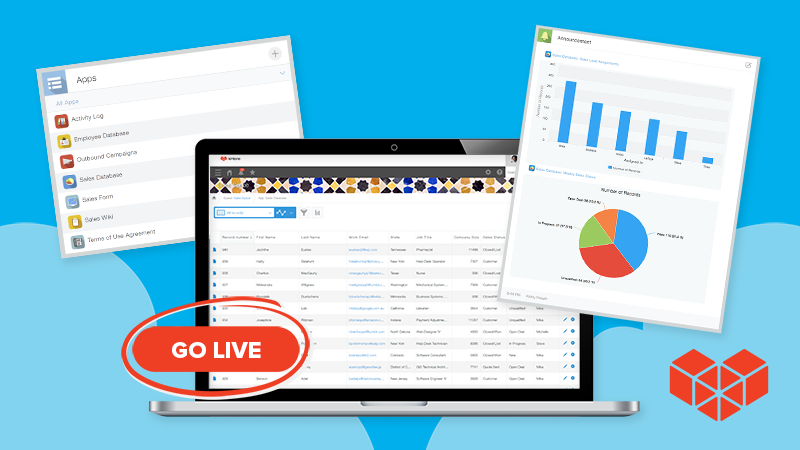Welcome to Kintone’s onboarding guide, part deux! In this piece, we’re going to get into the specifics of app planning and consideration, so if you haven’t already got everyone on board with the switch, then check out part one before you get into these weeds.
(Click here if you'd like to read Part 1, which covers how to bring your team and leadership onboard with changing to Kintone.)
Moving beyond the confines of traditional point-solution software is a big shift for any organization. Kintone is a very powerful and simple tool, but without proper onboarding preparation, you may quickly find your team getting stymied, frustrating progress, even potentially torpedoing the whole endeavor.
We want to change the way you work, so we’ve put together this quick onboarding guide that will address six elements of successful onboarding that will all but guarantee your team’s successful Kintone implementation. Buckle up, cause we’re going on a ride down to Easy Street.
Start Small
Once you’re greenlit on Kintone and everyone is ready to solve all their problems, it can be easy to fall victim to one of the classic blunders: Getting involved in a land war in Asia. Going in against a Sicilian when death is on the line. Over-scoping your first project.
When you’re just starting out, your best bet for success is to just pick one process you want to improve. Talk to your team and find something simple that everyone is sick of dealing with, and focus all of your efforts on fixing that process. A good place to start is any workflow process that has redundant steps in it (data entry, repeat verifications, emails that could be automated, etc.).
The most important thing to remember is not to stop until you’ve completely wrapped up an app that affirmatively takes care of the original issue. If the first app doesn’t actually work the way you need it to, keep working on it until it does. It doesn’t have to be perfect, but it does need to do the job, otherwise your team might start backsliding into old habits, and sink the momentum that you’re building together.
Map It Out
While you should definitely prioritize one project at a time, the key to maximizing Kintone’s potential is understanding what you want to do with it in advance. After all, you aren’t getting Kintone so you can solve just one problem, right?
Before you even touch Kintone’s app builder, get your whole team together and draw out your entire work process, start-to-finish. Like, physically draw it. (If you’re all remote, a board like Miro may be a good digital alternative to a whiteboard.) Just like how an author might read their work out loud before publishing, drawing your process out on a whiteboard or paper will make all of the inefficiencies of your work glaringly apparent. Get input from the entire team on which issues to prioritize so you’ll be ready to tackle the next problem once your first app is built.
One issue to keep in mind is that improving a process, especially if you’re moving a paper one to digital, is about more than just replicating an old process in a new format. It should be about fundamentally changing the process to make it more efficient.
Recommended:
Consider this: you have a process that involves taking a file and emailing it to your coworker. That coworker then checks the file and passes it onto the next person for final review and approval.
This process, despite being in email, is no different than if someone were to pass a paper between desks. The underlying workflow is the same despite the different digital mediums.
You’ll want to use your brainstorming sessions to challenge some of these intuitive yet wasteful process habits.
Throughout this brainstorming process, be sure to keep the excitement and momentum going with your team. Address problems as challenges to be overcome—and celebrate the solutions you create! Just remember: No two processes are alike. There is no cookie-cutter approach, so really take your time on this step. You’ll thank yourself later.
Involve Everyone
Seriously, anyone who might have even just a peripheral connection to the workflow should be consulted about your new process, especially management. Aside from the fact that they will very likely have some valuable input that can prove crucial to the viability and scalability of your solution, keeping everyone in the conversation shows that you’re serious about building for the long-term, which is what a company wants when they’re investing time and work-hours into a new project. (As mentioned earlier, be cognizant of how involved management should be; give them the opportunity to add feedback without making them feel bogged down in the details.)
Just make sure to be aware of your management staff’s style and personality so that you can keep leadership’s vision in line with your team’s goals and journey.
Besides all that, it’s just good office politics. Who doesn’t want to feel like their opinions are valuable?
Work in Phases
Any time you’re taking on a big project, it’s helpful to set up a series of small goals on your way to the big launch. Take your time, and experiment until you feel like it’s time to move on to the next step. Take breaks so you don’t suffer from software fatigue. It’s easy to find yourself getting caught in the weeds when you’re working with the nuts and bolts of process software design, so make sure to avoid burning yourself out.
As you advance through your project, make sure to revisit what you’ve already built. You’ll often be able to come back with fresh eyes and new knowledge that can help you understand your current position and move past obstacles easier.
Look for overcompensating processes and hidden processes that employees and managers create as part of the workflow. One way to spot where hidden processes are happening is to follow the Shadow IT trail. People have their own preferences, and folks set their own systems up. Get everyone on the same page and learn to trust the process you’re building.
Here are a few things to keep your eye on:
- Time taken to complete task
- Number of steps
- Number of clicks
- Number of people who touch the process
- Number of approval/verification points
- Departments involved
- Physical process flow
Celebrate Your Successes, Then Do It Again
Make sure to celebrate! Any time your team crosses a milestone or makes a breakthrough, take some time to acknowledge it and have everyone celebrate, even small victories. This is just good management advice generally, but it helps keep your team engaged and excited about crossing the next hill.
This goes double for launch day. When the time comes for you to unveil your app to the team/department/company, take the time to treat everyone to a party, drinks, a day off, or anything fun and relaxing. Your hard work deserves a just reward.
Always Be Iterating
Here’s the thing about software—it’s never finished. It can always be improved, and it should. Once your first application is built, each subsequent app is much easier to build. Kintone is a fully integrated platform, which means anything you build in Kintone can be made to share data with itself. As more apps are built, you’ll find new ways to improve your processes and apps that were made early on, then integrate them with each other.
Eventually, you may find that your original list of redundancies and inefficiencies has been addressed with Kintone. That’s when you go back and draw it all out again, further streamlining your work, creating a lasting, scalable process that will empower your team with the opportunity to experiment with their work.
We’re in This Together
Don’t forget—with Kintone, you’re never going it alone. We’re available to help you with anything you need, and we have a wide array of resources to help you out on your journey. We really do want to change the way people work, helping folks like you to get more joy out of your job.
Resources:
- Calculate your potential ROI using Kintone's ROI Calculator
- 7 Steps to Redesign a Broken Business Process
- Customer Resource Center: Helpful Guides For Using Kintone
New to Kintone?
Glad you found us! Want to learn more about bringing us on board with your team? Click here to schedule a 1:1 demo and consultation with a specialist who can answer any and all questions you may have.
About the Author
Mark is an avid writer with a ton of experience in journalism, experience design, performance, and event production. He also has impeccable taste in music. He currently lives and works as a writer/editor in the SF Bay Area. When he's not working, he's probably either spinning records or scoring goals on a bike polo court near you.










